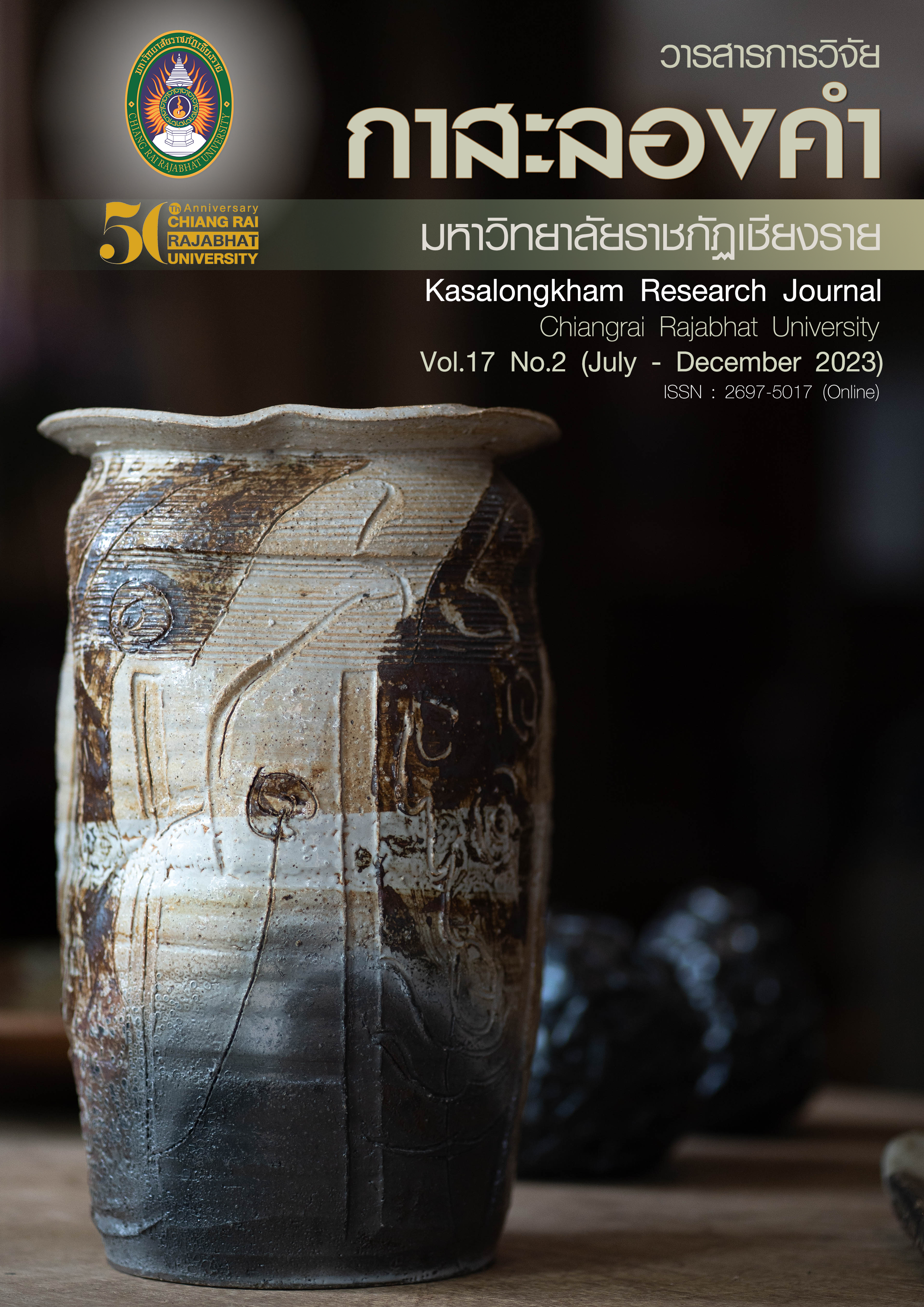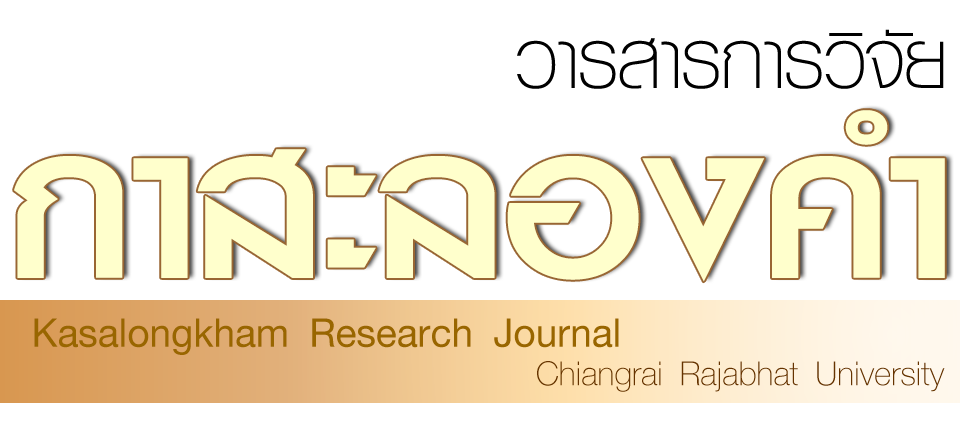The Concept of Residential Design of Chinese Dong Nationality
คำสำคัญ:
สถาปัตยกรรมจีนดั้งเดิม, ชนชาติต้ง, สัญศาสตร์ทางสถาปัตยกรรม, การสร้างอาคารเก่าขึ้นใหม่, การออกแบบแบบที่ปรับเปลี่ยนได้บทคัดย่อ
การตั้งถิ่นฐานและที่อยู่อาศัยแบบดั้งเดิมของชาวต้งมีคุณค่าทางประวัติศาสตร์ วัฒนธรรมและสถาปัตยกรรม อย่างไรก็ตาม การเร่งการปรับปรุงให้ทันสมัย การตั้งถิ่นฐานและบ้านเรือนต้งแบบดั้งเดิมจำนวนมากได้รับการปรับปรุงโดยไม่รู้ตัว หรือมีการพัฒนาอย่างไม่สม่ำเสมอ ดังนั้นการศึกษาวัฒนธรรมสถาปัตยกรรมต้ง เป็นทางหนึ่งที่นำไปสู่ความเข้าใจในการตกแต่งออกแบบภายในและภายนอกควบคู่ไปกับการสรุปผลไปสู่การพัฒนากลยุทธ์ในการปกป้องและอนุรักษ์สถาปัตยกรรมของต้ง ศึกษาทฤษฎีทำให้สามารถวิเคราะห์และเข้าใจประวัติศาสตร์ วัฒนธรรม และคุณค่าทางสถาปัตยกรรมได้ดีขึ้น วัตถุประสงค์ของการวิจัยคือ 1) ศึกษาสัญศาสตร์ของสถาปัตยกรรมประเพณีต้ง 2) ศึกษาประวัติศาสตร์ทุนทางวัฒนธรรมของสถาปัตยกรรมประเพณีต้ง 3) ศึกษาแนวคิด หลักการและตรรกะเชิงสัญลักษณ์ของต้งเพื่อการออกแบบใหม่ 4) เพื่อออกแบบห้องตัวอย่างให้สอดคล้องกับไลฟ์สไตล์สมัยใหม่ โดยใช้การวิจัยเชิงคุณภาพและเชิงปริมาณ เพื่อรักษาเอกลักษณ์ทางวัฒนธรรมให้สอดคล้องกับความทันสมัย จากการรวบรวมข้อมูลแบบสอบถามและการสาธิตการออกแบบแสดงให้เห็นถึงความหมายแฝงทางวัฒนธรรมของสถาปัตยกรรมแบบดั้งเดิมและการออกแบบบ้านที่ปรับให้เข้ากับไลฟ์สไตล์สมัยใหม่ ผลการวิจัยแสดงให้เห็นว่า ความยากในการสืบทอดทักษะทางสถาปัตยกรรมในการอนุรักษ์อาคารแบบดั้งเดิม การเปลี่ยนแปลงค่านิยมของคนรุ่นใหม่ของชาวต้งและการแสวงหาวัฒนธรรมต่างประเทศอย่างไร้เหตุผล เป็นปัจจัยสำคัญที่ทำให้เกิดการสูญเสียวัฒนธรรมสถาปัตยกรรมต้งแบบดั้งเดิมอย่างรวดเร็ว รัฐบาลท้องถิ่นสามารถชี้แนะและมีส่วนร่วมในการก่อสร้างหมู่บ้าน และผู้เชี่ยวชาญ ด้านสถาปัตยกรรมประเภทต่าง ๆ สามารถแนะนำผ่านการผสมผสานระหว่างเทคโนโลยีและวัสดุใหม่ ๆ ผ่านการบูรณาการสหสาขาวิชาชีพทำให้เกิดแผนการป้องกันและกลยุทธ์การพัฒนา รวมถึงปลูกฝังช่างฝีมือของอาคารแบบดั้งเดิม เพิ่มความภาคภูมิใจของชาติ และสร้างการพัฒนาอาคารแบบดั้งเดิมของชาวต้งที่ยั่งยืน เพื่อปกป้องและสืบทอดต่อไป
เอกสารอ้างอิง
Chinese Ethnic Architecture. (2022). The Treasure of Ethnic Culture: Architectural Cultural
Characteristics of Dong Ethnic Villages. https://baijiahao.baidu.com/s?id=1722461442847466018&wfr=spider&for=pc
Chizi Mengze. (2023). Mutual learning and integration of different ethnic cultures.
http://www.360doc.com/content/23/0109/12/1204156_1063056678.shtml
G. broderpenter. (1991). Symbols, symbols and architecture. Beijing: China Architecture and
Architecture Press.
Golden Age 554. (2022). Dong ethnic clothing patterns and their culture.
http://www.360doc.com/content/22/0319/00/18841360_1022167990.shtml
Huang Zengjun. (2011). Analysis of semiotic thinking of materials -- Material application and
concept evolution in architectural design. Tianjin: School of Architecture, Tianjin University.
Hui Xu. (2020). Research on the culture and Technology of local architecture in Southwest
China. Chongqing: Chongqing University.
Huimeng. (2018). Research on the relationship between Chinese ancient architecture and
Ancient Characters. Guangzhou: South China University of Technology.
Ikegami, Yoshihiko. (1985). Introduction to semiotics. Beijing: International Culture Publishing
Company.
Ji, J. J. (2020). Cultural geography of Traditional Villages and dwellings in Guangxi. Guangzhou:
South China University of Technology.
Lan Xiong. (2017). Cultural symbol system of Dong Ethnic Tourism Villages in the context of
tourism experience: A case study of Dong Village Zhaoxing in Liping County, Guizhou
Province. Guiyang: Guizhou Minzu University.
Li, H. R. (2009). Reliability and validity of deterministic studies. Harbin: Harbin Engineering
University.
Lin Cai. (2004). A Study on Traditional Villages and Architecture in Dong Ethnic Areas.
Guangzhou: South China University of Technology.
Longke Diao. (2023). Appreciation of Ancient Chinese Sculpture Works.
https://www.diaolongke.com/news/28194.html
R. Barthes. (1987). Semiotic aesthetics. Shenyang: Liaoning People's Publishing House.
Sanjiang county stylistic broadcasting Tourism Bureau.(2020). Solidified Music, Eternal
Memory: Dong Ethnic Wooden Architecture Construction Techniques. http://www.sjx.gov.cn/xwzx/sjyw/202102/t20210207_2513388.shtml
Xiaodan Zhang. (2020). Cultural creation brand design based on Semiotics -- a case study of
Zhaoxing Dong Village in southeast Guizhou. Chengdu: Sichuan Fine Arts Institute.
Xingxing Yuedu. (2021). The Artistic Characteristics and Aesthetics of the Dong Ethnic Group.
http://www.printdiy.cn/yingyuwenzhang/2021/0506/601432.html
Yujiao Wei. (2019). Evolution of Traditional Villages and buildings of Zhuang and Dong ethnic
groups in Guangxi. Nanjing: Southeast University.
Zhang xingzhao. (2018). The modern continuation of drum tower structure types and
construction techniques of Dong nationality in Tongpingtan River Basin. Changsha: Hunan University.

ดาวน์โหลด
เผยแพร่แล้ว
รูปแบบการอ้างอิง
ฉบับ
ประเภทบทความ
สัญญาอนุญาต
ลิขสิทธิ์ (c) 2023 วารสารการวิจัยกาสะลองคำ มหาวิทยาลัยราชภัฏเชียงราย

อนุญาตภายใต้เงื่อนไข Creative Commons Attribution-NonCommercial-NoDerivatives 4.0 International License.





